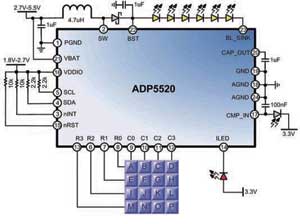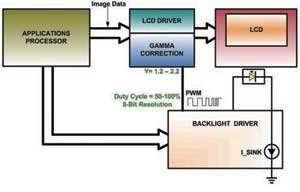Mobile devices have used black and white displays for some time, and their backlights use two green LEDs. The backlight consumes only 10% of the total power consumption of mobile devices. Today, multimedia devices use larger, higher-resolution color displays, and the time spent on displays has increased, and backlight power consumption has increased to more than 50% of total power consumption.
This article refers to the address: http://
Despite some new advances in battery technology, the increase in battery capacity has not kept pace with the increased energy requirements of multimedia mobile devices. As advances in battery technology can't keep up with battery demand, it's difficult for portable device manufacturers to meet consumer expectations. Unless new methods are developed to reduce power consumption or increase battery capacity, adding new features will inevitably shorten battery use. time.
In addition to time-based dimming, display pauses, and brightness settings (set by the user), many mobile device manufacturers are using ambient light sensing (ALS), content adaptive backlight control (cABC), and keyboard/GPIO expanders. To reduce current consumption.
For most portable device manufacturers, display backlighting is one of the most important causes of battery exhaustion. Media-intensive devices with high-resolution color displays require the display to be properly illuminated at all times to avoid optical degradation and readability.
Despite the need for continuous backlighting and relatively high power consumption, high quality transmissive displays are still favored by mobile device manufacturers. Compared to reflective displays, its indoor performance, NTSC (National Television Standards Committee) color saturation, high contrast and high brightness are superior. To reduce backlight power consumption, backlight intensity must be controlled and managed as closely as possible.
While backlight dimming saves power when not in use, many devices require features such as web browsing, email, GPS navigation, gaming, or video playback to maintain backlighting during prolonged user interaction.
One way is to adjust the backlight intensity through the brightness control in the product setup menu to save power during use of these functions, but this requires the user to enter information and change settings for different ambient lighting conditions in order to actually save power. effect. These methods are not practical for the user and are not sufficient for today's intensive and unique use cases.
Ambient Light Sensing (ALS)
The amount of backlight required for a liquid crystal display or keyboard varies greatly depending on lighting conditions. Ambient light sensing relies on photodiodes or transistors to measure local light intensity. The light source can be the sun, office lights or moonlight. The sensor converts the captured light into a current or voltage, and the backlight driver or processor can determine how much backlighting the liquid crystal display or keyboard requires based on a preset threshold.
In dim light conditions, driving the display backlight with the large currents required for sunny days not only wastes energy but can also cause eye strain in dark conditions. Changing the backlight intensity to ambient light conditions saves more than 60% of current compared to the current required to drive the backlight LED for typical use under bright conditions.
ALS Implementation Some manufacturers use analog or digital light sensor ICs to detect ambient light. An analog light sensor converts light into a current, and a digital light sensor uses an internal ADC to generate a digital bit stream. Analog light sensors are cheaper due to their simplicity of implementation.
Regardless of which sensor is used, the output needs to be decoded for use. Many designs use a host processor to perform sensor output decoding and backlight control. However, the main processor must be fast enough to provide multimedia functionality, and its higher speed and bandwidth also means greater current consumption when implementing ALS polling. Therefore, to reduce battery consumption, processor involvement must be minimized.
Some ICs integrate optical input decoding and backlight drive control. There are several advantages to integrating a light sensor in a backlight driver: first, the driver uses a simple state machine to accomplish the task, reducing the current required for decoding and backlight control to less than 20μA; second, everything is in one package, on the PCB The number of connections and leads is reduced in the layout; third, communication between the backlight driver and the host processor is minimized.
To provide handset manufacturers with greater flexibility, these integrated devices can be programmed to set thresholds, hysteresis, and filter times. Because the mechanical design of the product is different, the smart drive is required to be flexible enough to handle all conditions. Programmable thresholds allow handset manufacturers to program light input ranges such as daylight, office or dark environments, and hysteresis for each threshold prevents the backlight from jumping back and forth. The filtering time allows the user to set the time the phone is held in a certain lighting environment before making backlight adjustments. These adjustments make it easy to provide the flexibility that handset manufacturers need to correct for differences in parameters between different products.

Figure 1 Backlight driver with built-in light sensor input and micro keyboard / GPIO expander
Display Backlight Analysis The display backlight uses six LED strings driven with 18mA current to draw 111mA from the battery (assuming a forward LED voltage of 3.5V, a driver efficiency of 85%, and a battery voltage of 4V). Therefore, if the drive is always driven at maximum intensity, only the display backlight will consume 1100 mA.h of power within 9.9 hours.
The display does not require maximum intensity backlighting under all conditions, and reduces the intensity of the illumination when the ambient light is weak (such as in the office, movie theater, and outdoors), saving a lot of energy.
The brightness range on sunny days ranges from 32,000 to 100,000 lux, which is two orders of magnitude larger than the brightness of a bright office 400 lux. Therefore, reducing the backlight intensity by half or more when entering the room from outside will not cause any damage to the usability or readability of the display. Since most people spend 60% of their time in the office, this backlight brightness reduction can reduce current consumption by more than 50%. For the previous example, the backlight power consumption will be reduced from 111mA to 55.5mA. With ALS, the battery life of the 1100 mAh battery will be extended to 19.8 h for the same display.
Content Adaptive Backlight Control (cABC)
As shown in FIG. 2, Content Adaptive Backlight Control (cABC) is a method of analyzing display content and adjusting the display backlight using gamma correction techniques according to the gray level of the image. The display driver outputs the PWM waveform to the backlight driver and changes the duty cycle based on the gray level of the video content and using gamma correction to reduce the backlight for dark images. While maintaining a realistic display, this technology reduces backlight power consumption and improves display contrast. This method is especially useful during video playback because the picture may take longer to change from bright to dark. cABC also reduces the current consumption of still images and standard menu screens.

Figure 2 Content Adaptive Backlight Control (cABC)
These savings methods can be leveraged by modifying the user interface of the mobile product. With image data, cABC can reduce display power consumption by 20% to 50%. If combined with ALS, the energy savings can exceed 70%. IC manufacturers have leveraged the power savings of cABC combined with ALS in IC design.
Keyboard backlight In addition to the display backlight, ALS can also save keyboard backlight power. Most keyboards have a visible screen that does not require backlighting when enough ambient light is available. For a general-sized keyboard, a backlight based on LED or electroluminescent (EL) technology draws approximately 30 mA from the battery. Without ALS, the keyboard must be backlit at all times, consuming a lot of energy. With ALS, the backlight driver can turn off or dim the keyboard backlight to save hundreds of mA.h of energy. A backlight driver with integrated ALS control notifies the processor in an interrupted manner when the light changes, in order to change the keyboard or other peripheral lighting.
On a device that can play 7h video with a 1100mA.h battery and a 111mA backlight current display, the video mode power consumption accounts for 70% of the total power consumption. Relying on ALS can cut the backlight current consumption of the display by half, and the video playback time will be extended from 7h to 10.8h. Table 1 shows the energy savings from ALS in different lighting environments. The display and keyboard backlights in the previous example draw 141 mA of current when the backlight intensity is at its maximum. During the day, the keyboard backlight can be completely turned off and save 21% of the backlight current. The real current consumption savings are in the office and in the dark. In an office environment, the display backlight current can be cut by 50% without significant degradation in display quality, and the keyboard can be seen without the need for a keyboard backlight. With ALS implementation, total backlight current consumption can be reduced by 61%. In a dark environment, properly reducing the keyboard backlight and maintaining a large enough current in a dark environment can reduce the display backlight current to 24 mA and reduce total backlight current consumption by 62%.
Table 1 Comparison of the effects of ALS on backlight current consumption in different brightness environments

GPIO/Keyboard Extenders In order to make better use of the battery's power per mA.h, it is necessary to find all possible energy saving methods. In recent years, the amount of text messages has increased by a factor of 100. Young people send more text messages to friends and loved ones than on mobile phones. Although there is no power consumption like the backlight, each keystroke wakes up the application processor and consumes a few mA in a few ms. Thousands of key presses per day add up to quickly increase the power consumption, which in turn consumes tens of mA.h of battery capacity. To increase processor bandwidth and reduce processor power consumption, in QWERTY cellular phone designs, handset designers rely on keyboard extenders to handle keyboards. The keyboard expander handles all buttons, saving processor bandwidth and reducing power consumption. Features such as lock function and optical sensor decoding are also integrated into the IC, saving more bandwidth and power.
FIRSTPOWER offers a full assortment of storage batteries delivering a multitude of applications as energy storage power.Uses and applications include .
We welcome orders with "FirstPower" brand; We are also flexible to accept orders on OEM basis. Contact us now! Your partnership with FirstPower will prove worthy of it.
Storage Power,Storage Battery,Storage Power Gel Battery
Firstpower Tech. Co., Ltd. , http://www.firstpowersales.com